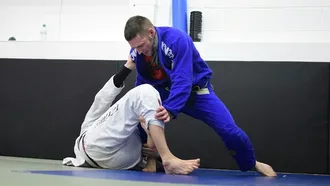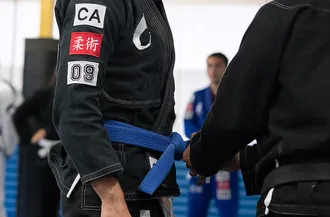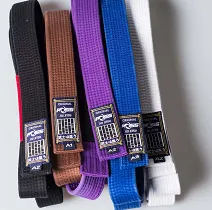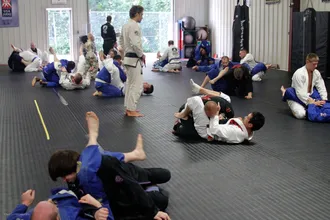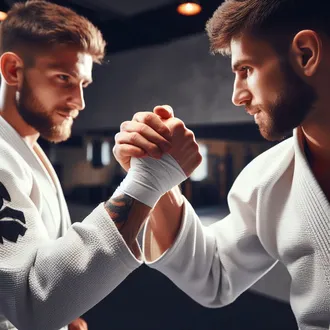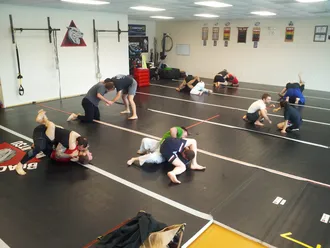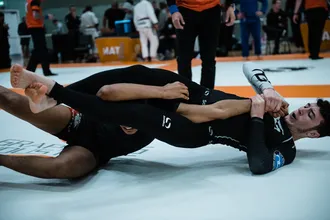
Jiu-Jitsu is for the protection of the individual, the older man, the weak, the child, the lady, and the young woman from being dominated and hurt by some bum because they don’t have the physical attributes to defend themselves. Like I never had.
Thinking about trying Brazilian Jiu-Jitsu (BJJ) but wondering, "Is BJJ dangerous?" or if it’s a safe sport? You’re not alone!
Many people ask, “Is BJJ dangerous, or is it actually a safe martial art?” The truth is, while all physical activities come with some level of risk, BJJ is one of the safest martial arts. Unlike striking-based combat sports, it relies on technique and control rather than brute force.
In this guide, we'll break down the facts, compare injury rates, and explain how safety practices make BJJ a smart choice for beginners.
Quick Answers
- ✅ Is BJJ Safe? Yes! BJJ has a lower injury rate than most martial arts.
- 📊 Injury Rate: 9.2–38.6 per 1,000 athlete exposures.
- ⚠️ Common Injuries: Joint strains, muscle soreness, skin infections.
- 🛡️ Stay Safe: Tap early, focus on technique, train smart.
- 🏆 BJJ vs. Other Sports: Safer than football, judo, and MMA.
Is BJJ Safe? Common Misconceptions
There’s a common misconception that Brazilian Jiu-Jitsu is a high-risk, injury-prone martial art. But the reality? BJJ is one of the safest martial arts you can train.
Unlike striking-based sports like boxing or kickboxing, BJJ focuses on grappling, control, and submissions, meaning there are no punches, kicks, or high-impact collisions.
Because most of the training happens on the ground, the risk of serious injuries—like concussions or broken bones—is significantly lower than in sports like football, Judo, or even basketball.
Of course, no sport is completely injury-free. However, studies show that BJJ has a lower injury rate than many other combat sports. Most injuries in BJJ come from minor joint strains or overuse, which can be avoided with proper technique and training under a knowledgeable instructor.
So, is BJJ safe? Yes! When practiced correctly—with controlled movements, respect for training partners, and the ability to tap out—BJJ is an excellent choice for beginners looking for a safe, effective martial art.
A Peek Into the World of Brazilian Jiu-Jitsu
Brazilian Jiu-Jitsu (BJJ) isn’t just another martial art—it’s a strategic, ground-based system that emphasizes leverage and technique over brute strength. It allows a smaller, weaker individual to control and subdue a larger opponent, making it one of the most effective self-defense disciplines.
Unlike striking-based martial arts like boxing or Muay Thai, BJJ focuses on grappling, positional control, and submissions, meaning there are no punches, kicks, or high-impact collisions. This unique approach significantly reduces the risk of serious injuries compared to other combat sports.
But does grappling sound dangerous? The reality is, BJJ training and drilling is designed with safety in mind. Practitioners are trained to apply techniques in a controlled manner, and the "tap out" system ensures that submissions are stopped before injury occurs.
With structured training, a strong emphasis on technique, and mutual respect between training partners, Brazilian Jiu-Jitsu is not only highly effective but also one of the safest martial arts to practice.
Brazilian Jiu-Jitsu vs. Other Martial Arts and Sports
When it comes to injury risk, how does Brazilian Jiu-Jitsu compare to other martial arts and sports? The numbers speak for themselves—BJJ has one of the lowest injury rates among combat sports.
A 2014 study published in the Journal of Sports Science and Medicine found that BJJ practitioners experience significantly fewer injuries (9.2 to 38.6 per 1,000 athlete exposures) compared to other martial arts like Judo (25.3 to 130.6 per 1,000) and taekwondo (20.5 to 139.5 per 1,000).
This research confirms what experienced practitioners already know: Brazilian Jiu-Jitsu is a safer option compared to high-impact combat sports.
But what about non-martial arts? Even when compared to mainstream contact sports, BJJ still ranks as one of the safest choices. Another study from the American Journal of Sports Medicine revealed that:
- American football has an injury rate as high as 81 per 1,000 athlete exposures.
- Ice hockey sees injury rates reaching 116 per 1,000 athlete exposures.
By contrast, BJJ's injury rates are much lower, making it a safer alternative to many popular sports.
Comparative Table – BJJ vs. Other Martial Arts and Sports
| Sport/Activity | Injury Rate (per 1,000 exposures) | Most Common Injuries |
|---|---|---|
| BJJ (Brazilian Jiu-Jitsu) | 9.2 | Orthopedic injuries (elbow, knee, foot, and ankle) |
| MMA (Mixed Martial Arts) | 236 (Nevada) 237 (Hawaii) |
Lacerations Abrasions Concussions |
| Judo | 25.2 to 130.6 | Upper extremity injuries (from grip fighting, throws, or attempts to throw) |
| Taekwondo | 79.3 | Lower limb injuries, head & neck contusions, sprains, and lacerations |
| Wrestling (Collegiate) | 30.7 (Matches) 7.2 (Practice) |
Not specified |
Safety Practices in Brazilian Jiu-Jitsu
What makes Brazilian Jiu-Jitsu one of the safest martial arts? The answer lies in its core principles: controlled movements, technical mastery, and a strong culture of safety and respect. Unlike striking-based combat sports, BJJ training focuses on grappling and positional control, significantly reducing the risk of high-impact injuries.
Training in BJJ is conducted in a structured, safe environment where practitioners learn to spar responsibly, recognize limits, and prevent unnecessary injuries. Here’s how BJJ prioritizes safety:
Tapping Out: The Ultimate Safety Mechanism
The concept of "tapping out" is at the heart of BJJ safety. When a practitioner taps out—either by physically tapping their opponent, the mat, or verbally signaling—it serves as an immediate request to stop the submission.
This ensures that submissions never reach the point of injury, allowing students to train at full intensity without fear of serious harm. The tap-out system fosters a respectful and injury-free training environment where practitioners push their limits safely.
Technique Over Strength: Why BJJ Reduces Injury Risk
Unlike martial arts that rely on striking, explosive power, or high-impact throws, Brazilian Jiu-Jitsu is built on leverage, precision, and strategy. This means that practitioners learn how to control an opponent without using brute force, reducing the likelihood of injuries caused by uncontrolled aggression.
By emphasizing technique over strength, BJJ minimizes dangerous movements and encourages a training style that is both effective and safe.
Proper Instruction: The Key to Safe BJJ Training
A skilled BJJ instructor plays a crucial role in injury prevention. In a structured class, students learn:
- How to fall safely (breakfalls) to minimize impact.
- How to execute techniques correctly without injuring training partners.
- When to tap out and recognize their limits.
Training under an experienced coach ensures that students develop the right habits, helping them progress in BJJ while keeping their bodies safe.
By following these essential safety principles, BJJ remains one of the safest and most beginner-friendly martial arts, allowing practitioners to train for self-defense, fitness, and competition with minimal risk.
Risks and Precautions
Let’s be real—while Brazilian Jiu-Jitsu is one of the safest martial arts, it’s still a full-contact sport. And like any physical activity, there are some risks to be aware of.
The most common injuries in BJJ tend to be joint-related, particularly affecting the shoulders, elbows, and knees. These typically occur due to improper technique, overtraining, or resisting submissions for too long.
How can you minimize these risks? The key is to train smart:
- Tap early and often – Don’t try to "tough out" submissions.
- Focus on technique – Strength can’t replace proper mechanics.
- Train under an experienced instructor – A qualified coach ensures you're using safe, effective movements.
- Listen to your body – Rest when needed and avoid pushing through pain.
By following these precautions, you significantly reduce your chances of injury while improving your overall performance on the mats.
Cauliflower Ear: Should You Be Concerned?
Cauliflower ear is a condition that some grapplers develop over time due to repeated impact on the ears. However, it’s not as common as people think—it requires consistent, high-impact training without protective measures.
Want to avoid it? Simple solutions include:
- Wearing BJJ ear guards during intense rolling sessions.
- Using proper head positioning to minimize ear trauma.
- Applying ice or compression at the first sign of swelling.
For most practitioners, especially beginners, cauliflower ear is not something to worry about.
Skin Infections in BJJ: How to Stay Safe
One overlooked risk in grappling-based martial arts is skin infections. Since BJJ involves close contact with training partners and mats, bacteria and fungi can spread if hygiene isn’t prioritized.
Common infections include ringworm and staph, but the good news is—they’re highly preventable.
How to keep your skin infection-free:
- Shower immediately after training to wash away bacteria.
- Wash your BJJ Gi, rash guards, and gear after every session—no exceptions!
- Keep your gym bag clean to avoid bacteria buildup.
- Check your skin regularly for any signs of infection and treat early.
By maintaining good hygiene habits, you can train BJJ without worrying about skin infections.
Frequently Asked Questions (FAQ)
What is the injury rate for Brazilian Jiu-Jitsu?
Studies show that the Brazilian Jiu-Jitsu injury rate ranges from 9.2 to 38.6 injuries per 1,000 athlete exposures, making it one of the safest combat sports. Compared to striking martial arts like boxing or Muay Thai, BJJ has a significantly lower risk of concussions and serious injuries.
Is BJJ injury-prone compared to other sports?
BJJ is far less injury-prone than many other martial arts and mainstream sports. While minor injuries such as joint strains can occur, the risk of high-impact injuries—common in football, Judo, and wrestling—is significantly lower due to BJJ's emphasis on technique and controlled grappling.
Does BJJ cause injuries?
Like any physical activity, BJJ can cause injuries, but the most common ones are joint strains, muscle soreness, and minor sprains. Serious injuries are rare, especially when training in a safe environment with experienced instructors. Practicing proper technique, tapping early, and listening to your body can help minimize injury risks.
Is BJJ safe for beginners?
Yes! BJJ is one of the safest martial arts for beginners. Since it doesn’t involve striking, the risk of concussions or broken bones is minimal. Training at a reputable gym with structured classes ensures that new practitioners learn proper techniques in a safe and controlled environment.
How can I reduce my risk of injury in BJJ?
To train safely and avoid injuries in Brazilian Jiu-Jitsu, follow these key principles:
- Tap early and don’t resist submissions beyond your limits.
- Focus on proper technique instead of using brute force.
- Train with controlled intensity—don’t go 100% every roll.
- Warm up and stretch before and after training.
- Choose a reputable BJJ academy that prioritizes safety and proper instruction.
By following these guidelines, you can enjoy the many benefits of BJJ while keeping your body safe and injury-free.
Is BJJ Dangerous or Safe? Final Verdict
So, is Brazilian Jiu-Jitsu dangerous? Not when practiced correctly. Compared to other martial arts and contact sports, BJJ is one of the safest options thanks to its focus on technique, controlled sparring, and the ability to tap out before injury occurs.
While minor injuries can happen—just like in any physical activity—serious injuries are rare when you train smart and respect your limits.
For most people, BJJ offers a safe, rewarding, and effective way to improve fitness, learn self-defense, and challenge themselves in a controlled environment.
Curious about what to expect? Check out what a BJJ class is like and take the first step on your journey!
